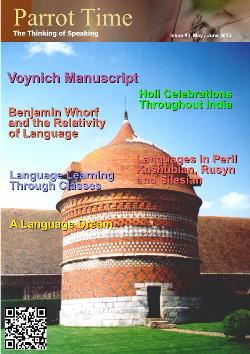The Voynich Script
Cryptic Codex

|
Translating  Sample of the text When Voynich submitted the manuscript to experts for translations, many expert cryptologists thought it would be simple decode. Indeed, it appeared to be written in some kind of valid language. The text has almost two-thousand glyphs, written with one or two strokes, but they are not all distinct, and an estimated thirty distinct glyphs could account for most of the text. Groups of these glyphs, separated by larger gaps than those between each glyphs, give the text flow. Put simply, the document clearly has letters and words. Some of the words occur more frequently than others, such as articles and conjunctions would. These words, approximately 35000, are of varying lengths and seem to follow some phonetic or orthographic laws, such as some letters must appear in each word, like vowels. Also, some letters never follow others and some may be doubled while others never are. These traits are all similar to most modern known languages and appear to follow Zipf's law of statistical frequencies in languages. There are even words that appear on most pages as well as some words that only appear in certain sections, suggesting some kind of vocabulary specialization. In the herbal section, some words only appear only as the first word on the page, suggesting that is the name of the plant being described. However, there are a number of orthographic oddities as well. Almost no words are more than ten letters. Similar to Arabic, some letters only ever occur at the beginning of a word, some always in the middle, and some only at the end. This is not found in most European languages however. Some of the words are more repetitious as well, with a few appearing up to three times in a row. Even odder, some words that are only different by one letter repeat more often than normal. Despite these apparent clues, the manuscript has not been successfully translated or even linked to any other known language. Zipf's Law Zipf's law, named after the American linguist George Kingsley Zipf who first proposed it, is an empirical statistical concept used to describe some aspects of natural language. Basically, it states that the frequency of any word is inversely proportional to its rank in the frequency table. In simple terms, the most frequent word will occur approximately twice as often as the second most frequent word, three times as often as the third most frequent word, etc. The law seems to hold true for most languages. That doesn't mean that no progress has been made. In the late 20th century, Prescott Currier made some very interesting statistical discoveries which he presented in New Research on the Voynich Manuscript: Proceedings of a Seminar in 1978. Among these, he showed that the manuscript is actually composed of two "languages". He called these simply A and B (sometimes referred to now as Voynich A and Voynich B). Each page was written in one of these languages, and the pages of one were grouped together with other pages containing the same language. This differed only in the herbal section. He also stated that the writing seems to have been made by more than one person, perhaps even anywhere between five and eight with distinct handwritings being used. He concluded that at least two people had written it.  Pages with odd drawings and text written correctly, sideways, and upside-down Another possibility is that the manuscript is written in an artificial, or constructed, language. Two prominent cryptologists who were studying it, W. Friedman and J. Tiltman, both came to this idea independently. Although these became popular in the later part of the 20th century, there is only one known constructed language before the time of the Voynich manuscript, and that was was the "Lingua Ignota", created by Hildegarde of Bingen in the 12th century. Still, many people believe that the manuscript is a hoax, created by one of the possible authors mentioned before for their own reasons. If Currier is correct about the idea of several people writing it, then the likelihood of it being a hoax is reduced, for it would require more people to be used in the deception. Another problem with the hoax theory relates to Zipf's law. It is doubtful that anyone could have accidentally created a text that conformed to Zipf's law, which were not themselves postulated until 1935. A constructed language however would follow that law. Today People around the globe continue to attempt to decipher the mysterious Voynich Manuscript. Many theories and ideas are being exchanged, and a few have even claimed to have cracked the code. Edith Sherwood claims that the names of the plants are Italian anagrams written in an elaborate script, and has presented her translations for those. Dana Scott has also come up with his own analysis of the botanical images and listed what he believes the plants to be. However, the names these two people have proposed for each plant do not match.  Villa Mondragone in Frascati, near Rome, where the manuscript was kept until Voynich purchased it in 1912 A Finnish businessman, Viekko Latvala, claims that he has decoded the manuscript, saying it can only be translated by someone with a "direct line to God". He also claims to be one such person. Latvala says the strange writing is actually "sonic waves and vocal syllables", and while the manuscript contains descriptions of plants, astronomy and astrology, it also contains prophecies. The text, he says, is a mix of Spanish, Italian, and other languages, used by the author because he had no language to write the direct word of God. This sounds a bit like Kelley's "language of the angels". Latvala even provides a translation of some parts, but there is no evidence that these are valid. There are many other theories surrounding the manuscript regarding its origins, authorship, contents and translations. It doesn't appear as though we will ever know the truth behind it, however, and it is more than likely that it will remain another of history's mysterious oddities. |
| Voynich Manuscipt - Cryptic Codex | ||||||||||||||||||||
| Writer: | Lucille Martin | |||||||||||||||||||
| Images: | ||||||||||||||||||||
| ||||||||||||||||||||
| Sources: | ||||||||||||||||||||
| ||||||||||||||||||||
All images are Copyright - CC BY-SA (Creative Commons Share Alike) by their respective owners, except for Petey, which is Public Domain (PD) or unless otherwise noted.
comments powered by Disqus



















